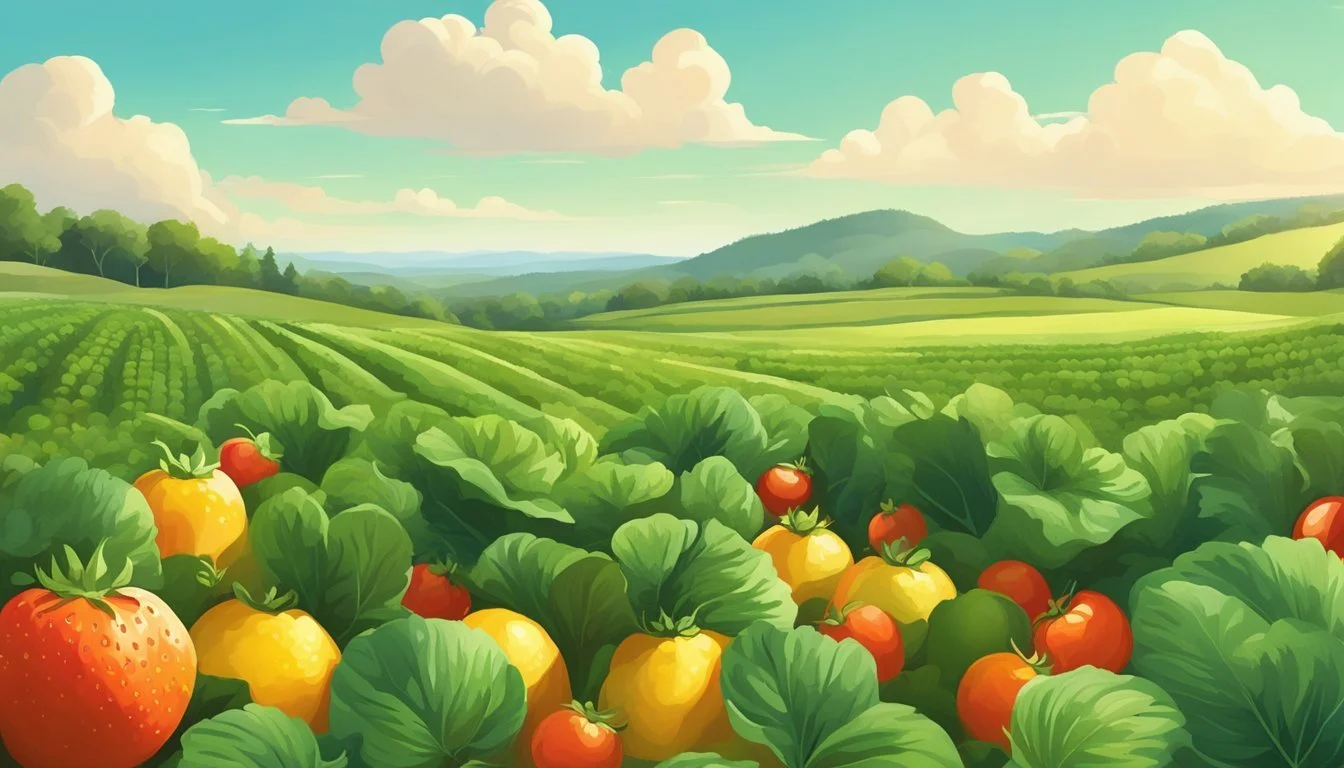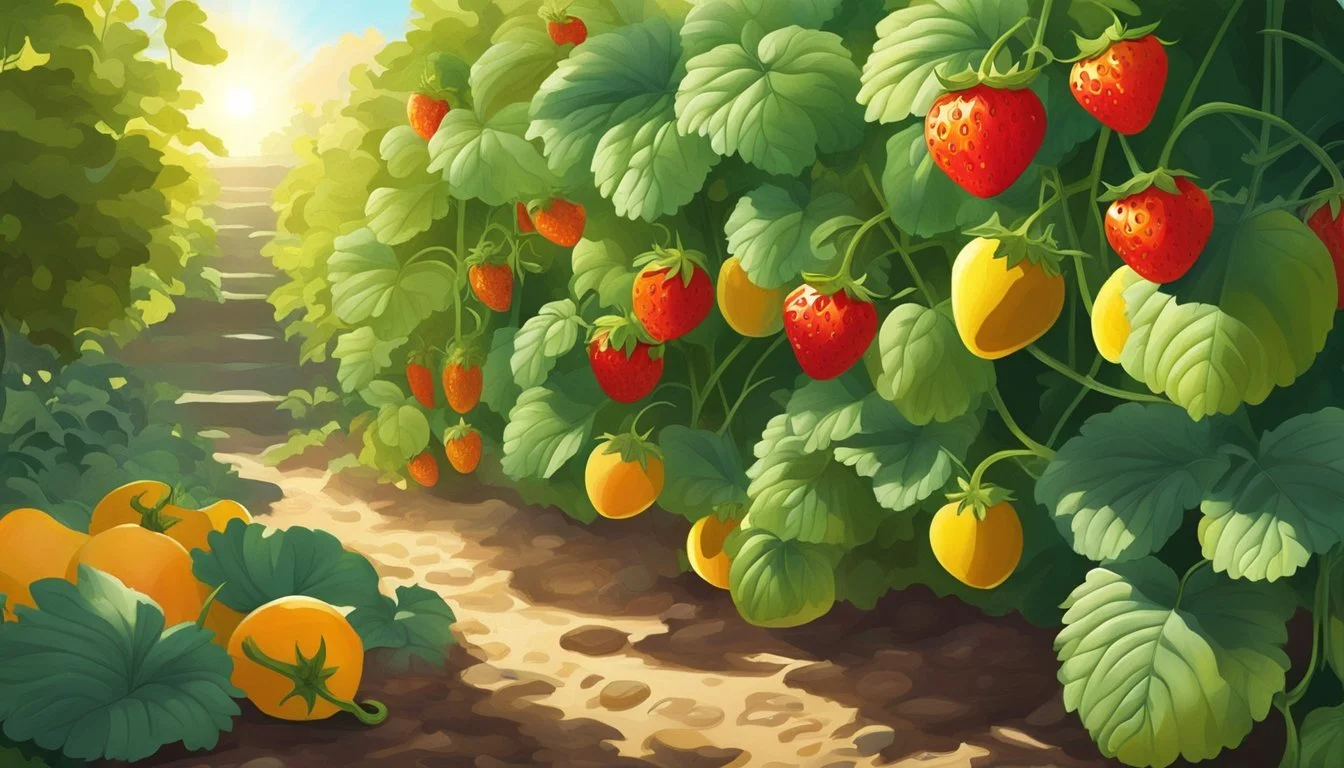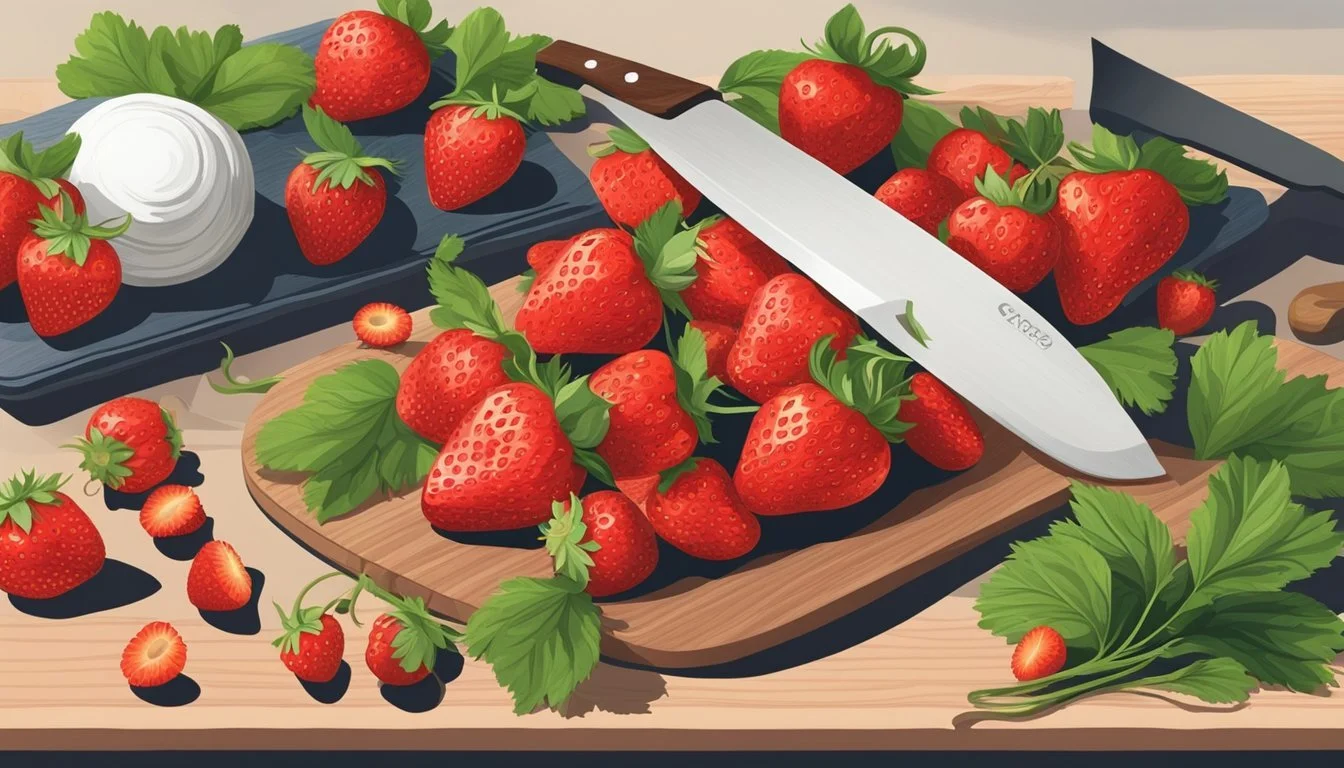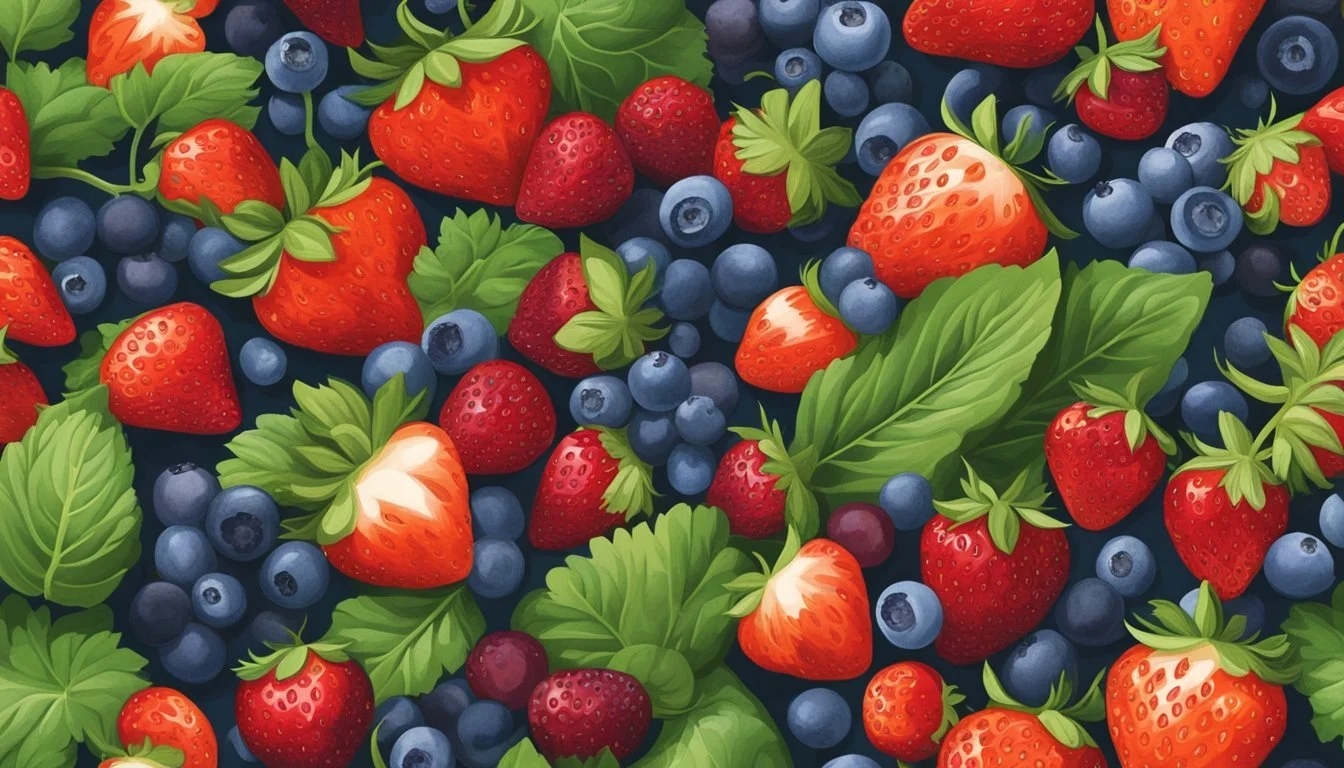West Virginia Seasonal Fruit & Vegetables in June
Your Fresh Picks Guide
This Article is Part of our West Virginia Seasonal Fruit & Veg Calendar
West Virginia offers an array of fresh produce in June, reflecting the state's diverse agriculture. During this month, farmers' markets and local gardens begin to brim with a variety of seasonal fruits and vegetables. June heralds the arrival of summer, and with it comes an abundance of fresh, flavorful, and nutritious options for the consumer seeking local produce.
Fruits such as strawberries start to wane as the month progresses, but there are plenty of other fresh offerings. Raspberries begin to ripen in June, offering West Virginia residents a sweet, tart treat perfect for homemade jams or fresh eating. It is also a peak time for garden enthusiasts and commercial growers alike to harvest various vegetables.
Among the vegetables, leafy greens like arugula thrive in the cool early summer climate of West Virginia and are available through this month. Asparagus (how long does asparagus last?)harvests continue into June, while beets provide a root vegetable option that is both versatile in the kitchen and rich in nutrients. This period marks a time of abundance, where the variety of local produce available is celebrated in kitchens and at dining tables throughout the state.
Seasonality in West Virginia
Understanding the unique seasonal cycle of West Virginia is crucial for consumers seeking the freshest produce and supporting the local economy. This state enjoys a rich diversity of fruits and vegetables thanks to its distinct seasons.
Understanding the Growing Seasons
West Virginia experiences four distinct growing seasons, each offering a variety of produce. Spring brings early greens and flowers, while the summer months provide a bounty of fruits and vegetables. As fall sets in, root vegetables and late-harvest crops become abundant, with a shift towards storage crops and winter greens as the cooler winter season approaches.
Benefits of Seasonal Eating
Eating seasonally in West Virginia means enjoying produce at its peak of freshness, which often results in better taste and nutritional value. Additionally, seasonal eating supports the local economy and is environmentally friendly, as it reduces the carbon footprint associated with transporting non-local foods.
June's Unique Position
June has a special role in West Virginia's seasonal calendar as it marks the transition from spring into summer. In this month, one can find the last of spring's offerings alongside the first of summer's harvest.
Fruits Available in June:
Strawberries: Rich in flavor, available until early July.
Raspberries: Start in June and last into August.
Vegetables Available in June:
Arugula: Available from May through September.
Asparagus: April through June marks the end of its season.
Beets: Harvest begins in May and continues to October.
June Fruit in West Virginia
As June arrives, West Virginia's climate nurtures a variety of fruits, with an emphasis on the ripening of berries and stone fruits. The state's fertile lands provide an optimal environment for these fruits to flourish.
Berries and Stone Fruits
West Virginia's June harvest is brimming with berries. Among the first to appear are:
Strawberries: These bright red berries are typically at the end of their season but can still be found fresh and ripe.
Blueberries: Entering their prime, blueberries are packed with flavor and nutrients.
Cherries (how long do cherries last?): Sweet varieties of cherries become available, offering a juicy burst with each bite.
In addition to berries, stone fruits begin to signal the start of a bountiful summer:
Peaches: While early in the season, some varieties of peaches start to reach maturity and can be savored for their sweet, fragrant flesh.
Melons and Apples
Even though most commonly associated with late summer and fall, some varieties of apples might make an early appearance in West Virginia during June, but these would be quite rare and are not the main focus of the month's harvest. Meanwhile, melons are generally not yet in season during June in West Virginia, with their peak availability occurring later in the summer months.
June Vegetables in West Virginia
As the gentle warmth of June sets in West Virginia, a variety of vegetables come into season. This period is noted for its abundance of leafy greens and vibrant herbs, a fresh assortment of root vegetables and legumes, as well as the early arrivals of summer squashes and the beloved nightshade family.
Leafy Greens and Herbs
Lettuce and spinach are in full swing in West Virginia during June. These leafy greens are known for their versatility and are featured prominently in salads.
Lettuce: Available varieties may include romaine, leaf, and iceberg.
Spinach: Fresh and tender, perfect for salads and cooked dishes.
In the herb section, basil and cilantro are bursting with flavor, ready to be harvested:
Basil: Aromatic leaves ideal for pesto and garnishing.
Cilantro: A fresh addition to salsas and dressings.
Root Vegetables and Legumes
In the realm of root vegetables and legumes, radishes provide a peppery crunch to dishes, whereas peas and beans emerge as the garden's staples:
Radishes: Crisp and spicy, excellent when sliced for salads or pickling.
Peas: Including sugar snap peas and garden peas, sweet and plump.
Beans: Green beans are just beginning to mature and offer a snappy texture.
Summer Squashes and Nightshades
Squash signals the start of summer's bounty, with zucchini leading:
Zucchini: Tender and ideal for a multitude of culinary uses, from sautéing to grilling.
The nightshade family begins its showcase with tomatoes, peppers, and cucumbers:
Tomatoes: Early varieties may be ready for harvest, promising juicy flavors.
Peppers: Bell peppers start to make their appearance, both green and beginning to color.
Cucumbers: Refreshing and perfect for cool summer salads.
Harvest and Storage Tips
In West Virginia, June's bounty of fruits and vegetables offers vibrant flavors and varying storage capacities. Ensuring proper harvesting methods and storage techniques can maximize freshness and extend the shelf life of produce. Those who prefer to enjoy these seasonal offerings year-round can employ freezing and preserving methodologies.
Optimal Harvesting Methods
Harvesting should occur during the cooler parts of the day to reduce stress on the plants and to help maintain the flavor and texture of the produce. Vegetables like leafy greens have the best quality when harvested in the morning, while fruits such as berries are ideally picked when dry to avoid spoilage. For root vegetables, one should wait until they reach a suitable size but before they become too large and potentially woody.
Proper Storage Techniques
Storing fruits and vegetables appropriately is crucial for preserving their freshness. Most vegetables benefit from refrigeration, typically in the crisper drawer to maintain humidity levels. For instance, leafy greens should be stored in a plastic bag with a paper towel to absorb excess moisture. Conversely, tomatoes should be kept at room temperature away from direct sunlight to preserve their flavor and prevent them from becoming mealy.
Fridge Storage for Common June Produce:
Leafy Greens (lettuce, spinach): In a plastic bag with a damp paper towel
Root Vegetables (beets, carrots): In the crisper, loose or in a perforated plastic bag
Berries: Unwashed in a container lined with paper towels
Freezing and Preserving
Freezing is an excellent way to extend the availability of June's harvest. One should blanch vegetables like peas and beans before freezing to preserve their color, flavor, and nutritional content. Berries can be frozen on a flat tray before being transferred to airtight containers or freezer bags to prevent clumping. Preserving methods like canning and making jams can also capture the essence of fresh fruits such as strawberries and cherries.
Local Markets and Farms
West Virginia's agriculture thrives in June with an abundance of fruits and vegetables. Local markets and farms are at the heart of this peak season, offering fresh, high-quality produce.
Finding Local Produce
Frequenting the local farmers markets is an excellent way to discover June’s seasonal offerings. These markets are brimming with fresh strawberries and raspberries, typically hand-picked in the morning for the utmost freshness. West Virginia's farms also hold regular market days, providing an authentic venue for purchasing directly from the source.
Supporting West Virginia Farms
Supporting local farms not only boosts the West Virginia economy, but it also ensures that the community has access to nutritious, seasonal food. In June, farms in West Virginia welcome visitors, offering everything from fresh produce to insights into agriculture practices. Buying local sustains farming traditions and helps maintain biodiversity within the state.
Community Supported Agriculture (CSA)
Community Supported Agriculture (CSA) programs allow individuals to invest in their local farms in exchange for a share of the harvest. These subscriptions are particularly bountiful in June, when community members receive a portion of seasonal crops while directly supporting agricultural endeavors. CSAs in West Virginia foster a strong connection between farmers and the community, ensuring the stability and growth of local agriculture.
Planning Your Garden
When planning a garden in West Virginia in June, gardeners should consider the selection of appropriate crops, the local hardiness zones, and the timing of the last frost to ensure a thriving garden.
Choosing the Right Crops
For a June start in West Virginia, gardeners should focus on crops that thrive in warm conditions and can be harvested in the late summer or early fall. They can consider vegetables such as tomatoes, peppers, and squash, which are well-suited for planting post the danger of the last frost. These warm-season crops benefit from the extended growing period afforded by the summer months.
Vegetables that can be planted in June:
Tomatoes
Peppers
Squash
Green beans
Cucumbers
Sweet corn
Understanding Hardiness Zones
West Virginia encompasses a variety of USDA hardiness zones, generally ranging from zone 5b to 6b. This impacts not only the types of crops that can be grown but also their planting times and care. Gardeners should refer to the USDA Plant Hardiness Zone Map to identify the exact zone for their location. This is critical to selecting plants that can survive and thrive in the climate conditions of their specific area.
West Virginia hardiness zones:
Northern WV: Zone 5b
Central WV: Zone 6a
Southern WV: Zone 6b
Last Frost Dates
Knowledge of the last frost dates is crucial for planting timing, especially for tender crops that cannot tolerate cold. In West Virginia, the last frost dates can vary greatly depending on the region. As a rule of thumb, the last frost date occurs earlier in the southern parts of the state and later in the northern regions. Planting should be scheduled for after these dates to minimize the risk of cold damage to sensitive plants.
Typical last frost dates by region:
Northern WV: Late April to early May
Central WV: Mid to late April
Southern WV: Early to mid-April
By adhering to these guidelines, gardeners in West Virginia can effectively plan and establish their gardens, providing a conducive environment for a bountiful harvest.
Seasonal Cooking and Recipes
In West Virginia, the month of June welcomes an array of fresh and flavorful produce. Cooking with these seasonal ingredients yields vibrant and nutritious meals that highlight the natural tastes of the region.
June-Inspired Dishes
Utilizing June's seasonal fruits and vegetables, home cooks can create dishes bursting with flavor. For instance, strawberries and raspberries are at their peak, making them ideal for desserts like a classic Strawberry Shortcake or a fresh Raspberry Tart. Savory options include incorporating snow peas in a crisp Stir-Fry or cherries into a Cherry Balsamic Glazed Chicken, balancing sweet and tangy notes with the savoriness of the meat.
Cooking with Fresh Produce
Cooking with fresh, seasonal produce not only enhances the flavor of dishes but also ensures the highest nutritional value. Ingredients like blueberries and peaches can be used to make refreshing smoothies or folded into pancake batter for a summery breakfast twist. Fresh watermelons and melons, with their hydrating qualities, can be turned into a fruit salad or pureed for a chilled soup, providing relief from the June heat.
Health and Nutrition
June in West Virginia offers an abundance of local fruits and vegetables that can contribute to a healthy diet. This produce is not only fresh and flavorful but also packed with nutritional benefits.
Benefits of Fresh Produce
Fresh produce is crucial for a balanced diet as it provides essential vitamins, minerals, and fiber that the body needs for optimal functioning. The nutrients found in seasonal foods support a variety of body functions from immune health to maintaining a healthy metabolism. Consuming fruits and vegetables in season from West Virginia ensures maximum nutrient content because these items are harvested at their peak and don't need long transport times that can lead to nutrient degradation.
Nutritional Content of Seasonal Foods
The nutritional content of seasonal fruits and vegetables in June varies:
Strawberries: Rich in vitamin C, manganese, and antioxidants, they support heart health and immune function.
Raspberries: High in dietary fiber, vitamins C and K, and antioxidants that may protect against chronic diseases.
Beets: A good source of folate, manganese, and potassium, beets contribute to good cardiovascular health.
Consuming a variety of these foods can help meet different nutritional needs:
Fruit/Vegetable Nutrient Health Benefit Strawberries Vitamin C, manganese Immune support, heart health Raspberries Fiber, vitamin C Digestive health, antioxidant Beets Folate, manganese, potassium Heart health, blood pressure
Integrating these foods into one's diet can contribute to overall health and wellness.
West Virginia's Agricultural Calendar
June marks a vibrant period in West Virginia's agricultural calendar, as the state enjoys a variety of seasonal crops. The temperate climate of West Virginia is conducive to many types of produce, and the agricultural calendar reflects this diversity.
Vegetables:
Arugula: May through September
Asparagus: April through June
Beets: May through October
Fruits:
Raspberries: June into August
Strawberries: June and July
This month, gardens and farms across West Virginia reach a peak in productivity, with warm days and cool nights creating an ideal growing environment. The agricultural community takes pride in the staple crops that have long been a part of the state's heritage as well as the newer additions that add variety to the local cuisine and markets.
Residents and visitors alike can experience the freshness of West Virginia's produce by exploring local farmers' markets, pick-your-own farms, and community-supported agriculture programs. Crop availability is subject to change due to weather conditions, but the June calendar generally promises an abundant harvest. Consumers can enjoy the seasonal bounty that this region of the United States provides, relishing the fresh flavors and supporting the local farming economy.










